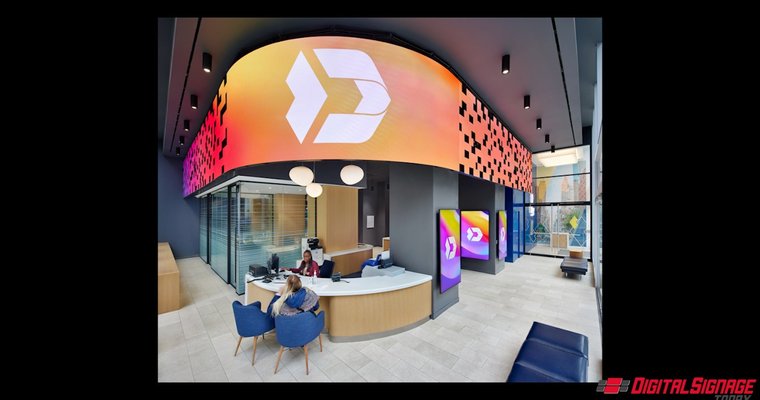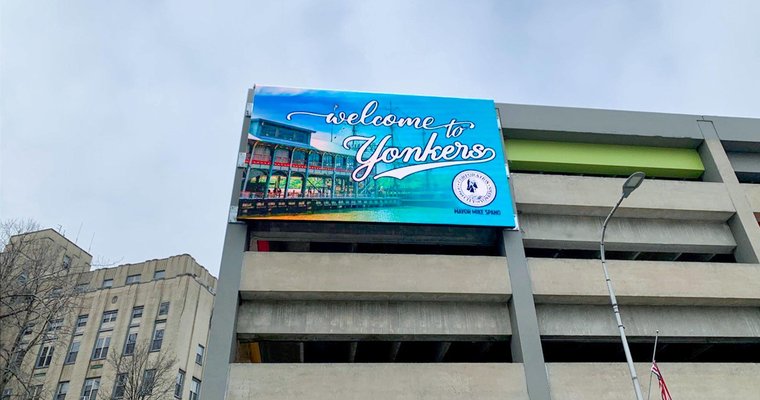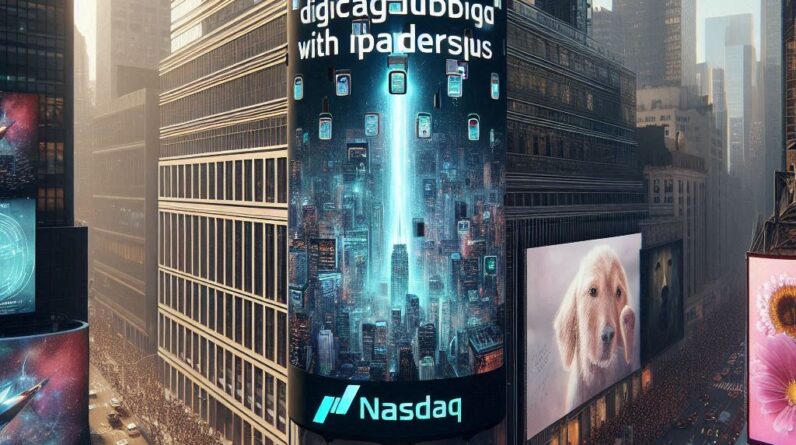
[ad_1]
Brad Cooper, banking expert and editor at ATM Marketplace, weighs in on the Valley Bank digital transformation recently covered by Digital Signage Today editor Daniel Brown.
 Image credit: Courtesy of Valley Bank/Adrenaline.
Image credit: Courtesy of Valley Bank/Adrenaline.
Brad Cooper, banking expert and editor at ATM Marketplace, joined Digital Signage Today via video link to weigh in on the Valley Bank digital transformation that was recently covered by Digital Signage Today editor Daniel Brown.
Valley Bank’s Fifth Avenue flagship branch embraced major digital signage installations in partnership with Adrenaline, which provided design and implementation. In the wake of major financial sector news events like the collapse of Silicon Valley Bank, Cooper argues that the project is an example of how to engage customers and kindle confidence through combining cutting-edge technology innovation with the human touch.
“You’re listening to what customers say and you’re engaging them in a conversation,” Cooper said. “I think that’s really the secret sauce: How do you engage your customers in a conversation?”
As mentioned in the interview, Daniel Brown and Bradley Cooper will both be at the joint ICXA and BCX Summit in Charlotte, NC this year. Users can register for the ICXA summit in Charlotte, NC with the discount code AMCEDIT20.
The full video is available below, along with a full transcript; the interview has been edited for clarity and length.
Images courtesy of Valley Bank/Adrenaline. Stock footage courtesy of Adobe Stock.
Interview Transcript
Daniel Brown:Okay, well, Bradley Cooper, thank you for joining us here at the Pixel Pitch, can you introduce yourself and tell us a little about your work.
Bradley Cooper:So I am the editor of ATM marketplace, which is a sister site to Digital Signage Today (although I have written for Digital Signage Today before). ATM Marketplace — even though the name ATM is in there, we try to focus on a lot of different aspects of banking. So, a lot of the self service transformations, the branch transformations that happened; we’ve dabbled a little bit in Bitcoin cryptocurrency. But really we also like to look at: what’s the customer experience like? Like, how are banks transforming their customer experience and utilizing these new technologies like AI, automation, you know, more advanced ATMs that do more than just spit out cash?
Brown:Yeah, so we’ve recently covered the Valley Bank digital transformation, which — kind of a fascinating example of stuff we’ve been talking about for the past year, really, in terms of the human side, the human element of business, combined with cutting edge technology, and really sort of engineering an experience —experiential marketing, but it’s more than that, you’re crafting an experience that hopefully is memorable for users. And that’s kind of become the watchword across so many industries. What stood out to you as an expert in the field about this story?
Cooper: Sure. So I think when you look at digital signage and banks, what you typically, you typically don’t think of something to advanced — like, when I think of digital signage and banks, I think of, you walk into the branch, and there is a small sign in the back that just has all this information about credit cards or mortgages, but there’s so much information overload that most people are just going to ignore it. So, I think the fact that this bank decided to do something a little bit different, decided to make a very experiential, almost something you would expect to see outside almost even in Vegas sometimes, and the fact they decided to do that, I think makes them stand out and makes people think, ‘Oh, okay!’ And then even if they don’t necessarily go inside that bank, that might be something they remember, they might go home and Google that bank and say, ‘I wonder what that banks like.’ I mean, because a lot of people are looking at their banks right now, especially in light of SVB and First Republic bank. And they’re saying, is this an organization I can trust? Do I need to switch? Should I consider like some of these other entities like Apple or something like that? So I think then making them stand out is really interesting.
Brown:Well, for sure. Yeah. So Valley Bank leaned heavily into revamping their digital signage and creating a dynamic digital canvas. So they have this beautiful and — this beautiful renovation of their Fifth Avenue branch, which again, as a signage nerd, I’m just like, I love aesthetics. It’s sort of, they said, the message in New York City that they wanted to convey was, ‘Hey, we’re here. And we’re here to stay.’ And the bank is trying to lean into look, we have the cutting edge tech, but you’re still going to talk to a human, you’re still going to be treated like a person with dignity, all these other things. Tell me a little bit more about that. But also, for those of our listeners who don’t really know a lot about maybe banking, or SVB, can you give us background on you mentioned Apple, SVB. And I think there’s a third?
Cooper: Sure. So there’s been some news recently about several big name banks like Silicon Valley Bank and Signature Bank, and they collapsed. And that was due to the fact that these banks took out some risky investments. And they also took out in the case of SVB, they took out some government bonds, which went down, because the feds have been trying to reduce inflation. And as a result, the value of bonds go down. But also these banks, especially like SVB, they’re investing in these, these tech businesses, or startups that a lot of times tend to go under. So as a result, there was a huge run of people going to withdraw their money from their accounts, and that caused these banks to go under because they noticed, oh, man, we’re like, several billion dollars in the hole in many cases. And in the case of First Republic Bank, I believe it was $100 billion. A big reason why these failed is that they had a large amount of on what’s known as uninsured deposits, whereas it’s like — so the FDIC, the Federal Deposit Insurance Corporation, they will insure money up to $250,000 of deposits, and that’s been around since the new deal in the 1930s. But when a lot of banks have uninsured deposits that are way over that amount, well, the problem is, what becomes when they start losing money? And those people are panicked, because they don’t want to lose their money over that amount. So they go and withdraw their money. And I believe there was an expert, who recently said, and let me see if I can — let me let me pull up his quote here for a second. I think it’s a great quote. But essentially, there’s a lot of arguments right now about whether these bank collapses are something endemic perhaps in our financial system, or it’s something more with these particular banks themselves. So, okay, Michael Milken, who is a financial expert, he said, “This is not the 1980s. It’s not the 1970s. It’s not the great, great financial crisis.” (And he said this during the Milken Institute Global Conference.) “But it’s a lesson again, that we need to match those that buy long term assets with those that have long term liabilities, like pension funds, insurance companies; and our financial institutions cannot run a mismatched book of short term liabilities and long term assets.” To go back to your original point about what I meant by Apple. So Apple recently worked with Goldman Sachs, to release a savings account that offers I believe, it’s 4.15% interest rates, which is very high, not the highest, but it’s a very, very high interest rate for savings. And it’s integrated with your iPhone, it’s integrated with your Apple Wallet. So within like four days, they got nearly a billion dollars of deposits from people. Some people are asking, Okay, are banks receiving a new challenge from these companies who are going to come out with our own products? And what’s interesting was, I talked to E.J. Kritz, who is a big, big friend of our company, big friend of ICXA, a and big friend of the BCX Summit. And he said that banks still have an inning with their customers in the terms of trust, they still have that trust relationship. And they need to work on developing that, rather than trying to catch up with all the techie stuff. Rather than trying to catch up with every single innovation that comes out, focus on the relationships, which it’s — to bring it all together. That seems to be what Valley Bank is doing, where they’re innovating in this one way to be like, here’s our makeover. But this is, this is just an extension of what we were already about, which is about reaching the needs of our customers and having that personal touch. That seems to be my impression.
Brown:Well, the human element, I love that designing a human-shaped experience where someone feels valued and their needs are met. And it’s funny you say that, because I think was at the Restaurant Franchising Innovation Summit in Miami earlier, this year that I heard a very, an old legacy restaurant brands said, look, and I’m gonna butcher this, but they basically said, Look, we like to say that we evolve, but we do not change — and what they meant was: Our strategy is we’re going to use new tools when they come out. But we’re still going to provide the same experience that people have known us for for generations. And I think what struck me about this bank transformation was that they’re trying to do a similar thing. Look, it’s going to be the same experience with even better technology. The narrative that I seem to be observing is, look, there’s a rise in the so called ‘neo-bank’ where these new companies hybrids with with banks, and consumer confidence in traditional or legacy banks, is relatively low. According to polls, at least that’s what I’m seeing as a non-expert, just reading. So one way to overcome this, I want to delve into strategy with you here, for banks, and also for businesses in general, winning that consumer confidence seems to involve a principle we’ve covered, you know, business is a relationship, and this is something that ICXA has talked about — the interactive customer experience Association. Business is a relationship, and you need to cultivate and invest in that relationship. It’s not just, as you say, about the technology. Can you tell us a little bit about that? How do you establish and maintain such a relationship, especially with so much change happening?
Cooper: Yeah, it’s very difficult. And once again, I’ll quote our good friend, E.J. Kritz, who said, with some of these organizations, if you didn’t have press to begin with, it’s very difficult to build it afterwards. But what I personally think is you need to look at technology and your strategies all within the realm of how will this benefit the customer? And how will this improve the customers’ lives? How will this make the customer more charitable toward my brand? And to borrow to borrow some lessons from advertising, banks and a lot of businesses, they need to take a good hard look at what their brand equity is like, what is their brand actually worth? What do people think about when they think of their brand? What’s their brand image? And a lot of — unfortunately, some banks don’t really have a clear brand image. It’s more, oh, we’re safe with your safe with your money. I think that’s something that banks and every business needs to consider — what do people think of, do they have a clear image in their head? And so by developing that brand image, you can also have an opportunity to develop that customer trust, for example, if you want to develop a brand image of: We are the most responsive bank you’ll ever find. Well, there are lots of good ways to do that. For example, you can have a very strong social media presence where you — if someone has a complaint about the bank, you’re right on it and say oh, let me help you with that, or even stuff, like just having a much more open communication style. Where you’re not just up on high, delivering, you know your message, about your newest savings account or credit card or whatever. But you’re also listening to what customers say and engaging them in a conversation. I think that’s really the secret sauce: How do you engage your customers in a conversation? And it’s very difficult to do, in many cases.
Brown:So in other words, I love that it’s a dialogue, and you need to listen to your customer and listen to their needs. It really sounds like a lot of dating advice I’ve seen in various magazines, right, listen to your partner and meet their needs proactively. And I’m curious how you feel, I’ve heard this at events. I don’t know if it’s true. I’ve heard this idea that banks need to stop thinking of themselves as different from other categories of business and realize everything is about customer experience. And that’s how you need to view it. And this this TED talk that has been going around virally, where someone said, Stop — he basically said something like — stop selling products. Create experiences. Yeah. Do you think this is penetrating in the banking industry?
Cooper: I think it’s starting to, and I’ll use a specific example. So with ATMs. So within ATMs, there’s been a little bit of maybe, maybe a tiny bit of tension between the ATMs and the kiosk industries, because ATMs are like the first self service device. But the kiosks come along, and they want to differentiate themselves. They say, Well, we’re not really a kiosk, we’re an ATM. And so there’s, there’s a bit of clash there over product identity and brand equity and all that. But it seems like we’re starting to see ATMs drift more towards, like, a self service model. Like okay, we’re not just an ATM, we’re now a full self service banking solution. Where, if you go in, and you might be something like an interactive teller machine, where you go after hours, you can get on a video with someone, or you can do tasks like even like opening an account or, you know, deposit depositing cash is the big is the big one that a lot of ATMs now integrated. But just this overall trend of how can we take this machine and turn it something that’s a full self service solution? Let’s integrate it like many kiosks are today. So, I think that is part of a general trend. And you also see, banks are really looking at okay, obviously, we have an issue with how we’re relating to our customers, how can we fix that? How can we integrate? How can we integrate technologies like automation, but do it in a smart way? How can we take things like chat bots, and do it in a smart way so that it really benefits our customers and can resolve the issues — that can resolve a lot of issues for them? So that’s one thing I’m seeing.
Brown:It’s interesting, because it sounds like a lot of the interactive technologies in pro AV and digital signage are also being used here. I’m thinking of this amazing, and I’m gonna ask you to tell me more about this video conferencing, it sounds like talking to a teller or a banker, virtually, which is similar to a lot of the technologies for conferencing that we’ve seen in digital signage. And also this, just the general interactivity, tell me more about this, is it this, like, 24/7 — you can talk to someone? And what kind of banks are instituting this.
Cooper: So, it varies. There are two types. Some of them are like drive thru ones where you can call a teller, a lot of them are inside. But essentially, it’s about expanding the branch hours, right? So maybe after hours, you need to talk to a bank teller about something or maybe you’re having an issue, well, if the branch is closed, because a lot branch hours are reduced, for various reasons, you can use this machine to contact a banker. And you know, people are very familiar with Zoom. So it’s like a Zoom chat with a banker. And I was just going to bring up just as another example of how digital signage is interacting with banks. So, I recently got a story from a company called Travelex who they they’re a foreign exchange, foreign currency exchange company that helps people exchange cash for whatever currency they’re in. And they recently deployed some ATMs at various airports throughout the U.K. And with some of their ATMs, they’re actually installing 2.5 millimeter direct view LED screen wraps around the three sides. And these in the content on the screen wraps are dynamically matched to what flights are departing. So that way, you know, people can be reminded, oh, I need to go exchange my cash for this new currency. And they’re also working to link it with relevant data such as weather and demographics. So we’re really starting to see, and it’s still slow going. But a lot of these machines are integrating all these different technologies together to create a really omnichannel, exclusive — not exclusive — inclusive customer experience.
Brown:Well, it’s, it’s interesting that you mentioned that it strikes me that instead of being afraid of changing times and new technologies, a lot of businesses that are saying Wait, this is an opportunity, we can leverage this for better user experience, and growth, and profit, all in one. Tell me a little bit. First of all, is that crazy to say? And secondly, I’m curious about the accessibility and DEI side of all of this technology with ATMs and so forth.
Cooper: A lot of these ATMs that you can see, I mean, they obviously have Braille. But it’s pretty common now for them to have some sort of port where you can plug in some headphones. It’s still a pain point for a lot of industries, right? Because a lot of industries, there’s always there’s always an opportunity for a lawsuit somewhere, because maybe something wasn’t done correctly. I think companies are coming up with great solutions for that, but it’s still gonna be a pain point in many different industries.
Brown:For sure. Well, I’m curious, you know, in terms of this weird, interesting intersection between banking and digital signage that we’re seeing here, what are some other areas that you see, areas of opportunity, where the banking industry as a whole could start using more digital signage and pro AV tools in its toolbox for this customer experience?
Cooper: Ooh, well,there’s a lot of ways you could do it. I think one way you could do it is by integrating attract screens more often in ATMs. So attract screens are essentially, you take a kiosk or an ATM, and before the customer interacts with it, it’s playing content. So what are you gonna do with that content? Well, you can use it to sell products, or you can even use it to sell services or tell people, Hey, here’s this other service we offer that you might not be aware of. And it could even be, you can even sometimes tailor it to customer data. So maybe when there’s a waiting screen, there’s like an advertisement pop up, or even something a little bit more specific like this could help benefit you in this way. So I think sometimes it’s used to using the existing tools you have and integrating new elements like, well, we have the screen, how can we use it. And I think with your example that you brought up that we’re talking about, Valley Bank, this is just another example of taking your physical space and making it that that old buzzword phygital, you know, you’re using a physical space, but you’re also integrating digital elements to make it a more immersive environment that people want to go to. With a lot of the unbanked and underbanked. Some some of those people are intimidated by going into a bank.
Brown:Yeah. So it’s like, so people are intimidated? Well, and I’m curious too, even with the banking hours issue, you mentioned, maybe people have to work during banking hours, so they don’t have the transportation to get to a bank during banking hours. So this might be a way to democratize — technology, democratizing resources, for everybody.
Cooper: And we even see this maybe on the digital banking side, of people integrating more of these tools that are helpful for the average user, maybe stuff like, basic stuff like savings tools, where if you purchase if you make a purchase, it will round it up to the nearest dollar and send those extra cents to your savings account.
Brown:Well, I’m curious, and again, you’ve been so generous with your time and the middle of a very busy day. Do you have any burning thoughts as we look at this new intersection between the industries that we cover day to day, do you have any burning thoughts to share for both audiences?
Cooper: I think to a certain degree, we need to we need to, have good ex— we need to have, not conservative expectations, but moderate expectations. So there are going to be some industries where this is really well integrated, and others where it’s not as much. And I think we’re gonna see a lot of stress and a lot of pain points around how much of it can we deploy. And some of them might even deploy way too much. And it’s, it causes some problems. So I might not do it well enough. So I think there’s going to be, there’s going to be quite a lot of pain points going forward. But I think we are going to see some very interesting solutions that might surprise us.
Brown:Well, I love that. And I think that’s a great way to tie everything together. You know, what is the constant in a world of change? Businesses are struggling to keep up: Metaverse, AI, chatGPT. Well, just like we saw with this historic bank branch, right, that had this digital renovation, if you lean into the constant principles of user experience, meet your users needs, innovate, but keep it human-shaped, you’re going to be okay, you’re going to be more than okay is what I tend to see we’ve covered the airport industry, we’ve covered transportation, so many industries, where that seems to be one of the biggest rules, take care of your customer. And as you say, listen to your customer, and you’re going to weather whatever changes may come.
Cooper: before we go off, I just want to plug so if you’re interested in banking, you can subscribe to atmmarketplace.com. And we also have an event coming up, the Interactive Customer Experience Summit, which will be held together with the Bank Customer Experience Summit. And that’s being held in Charlotte, North Carolina from September 11th through 13th. For the banking side, being held in the 12th through the 13th. And if you want to register for that, I actually have a code. You can use the code AMCEDIT20 at checkout to get 20% off, so if that’s something that interests you, please register we’d love to have you.
Brown:And just to sweeten the pot, both of us are going to be there, so you’ll get the dazzling intellect and charisma of the two of us, it’s going to be too much for most people.
Cooper: Yeah It’ll be fantastic! Well, thanks so much, Daniel.
Brown: Chat soon!
Transcript prepared with help from Otter.ai, with corrections from editor.
Daniel Brown is the editor of Digital Signage Today. He is an accomplished technology writer whose experience includes creating knowledge base content for a major university’s computing services department. His previous experience also includes IT project management, technical support and education. He can usually be found in a coffee shop near a large pile of books.
[ad_2]
Source link






